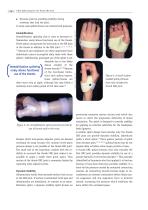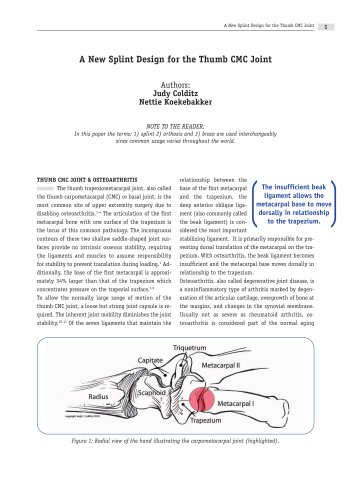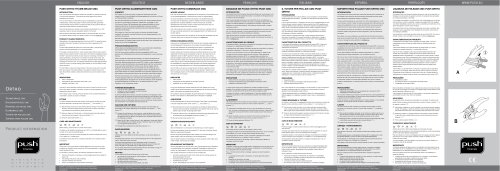
Catalog excerpts

A New Splint Design for the Thumb CMC Joint A New Splint Design for the Thumb CMC Joint Authors: Judy Colditz Nettie Koekebakker NOTE TO THE READER: In this paper the terms: 1) splint 2) orthosis and 3) brace are used interchangeably since common usage varies throughout the world. THUMB CMC JOINT & OSTEOARTHRITIS The thumb trapeziometacarpal joint, also called the thumb carpometacarpal (CMC) or basal joint, is the most common site of upper extremity surgery due to disabling osteoarthritis.1-4 The articulation of the first metacarpal bone with one surface of the trapezium is the locus of this common pathology. The incongruous contours of these two shallow saddle-shaped joint surfaces provide no intrinsic osseous stability, requiring the ligaments and muscles to assume responsibility for stability to prevent translation during loading.1 Additionally, the base of the first metacarpal is approximately 34% larger than that of the trapezium which concentrates pressure on the trapezial surface.5-9 To allow the normally large range of motion of the thumb CMC joint, a loose but strong joint capsule is required. The inherent joint mobility diminishes the joint stability.10,11 Of the seven ligaments that maintain the relationship between the The insufficient beak base of the first metacarpal ligament allows the and the trapezium, the metacarpal base to move deep anterior oblique ligadorsally in relationship ment (also commonly called to the trapezium. the beak ligament) is considered the most important stabilizing ligament. It is primarily responsible for preventing dorsal translation of the metacarpal on the trapezium. With ostearthritis, the beak ligament becomes insufficient and the metacarpal base moves dorsally in relationship to the trapezium. Osteoarthritis, also called degenerative joint disease, is a noninflammatory type of arthritis marked by degeneration of the articular cartilage, overgrowth of bone at the margins, and changes in the synovial membrane. Usually not as severe as rheumatoid arthritis, osteoarthritis is considered part of the normal aging Figure 1; Radial view of the hand illustrating the carpometacarpal joint (highlighted).
Open the catalog to page 1
A New Splint Design for the Thumb CMC Joint process, and is most likely to involve the joints that receive the most use or stress over the years.12 Symptoms of osteoarthritis may include joint pain, tenderness, stiffness or instability. CMC osteoarthritis causes increased laxity of the joint capsule, creating the common clinical compliant of pain with resisted thumb motion, particularly forceful pinching. Movement of one bone end against the opposing joint surface creates pain.13 Osteoarthritis is part of the normal aging process, involving joints that receive the most stress. Figure 2:...
Open the catalog to page 2
A New Splint Design for the Thumb CMC Joint Figure 3: One in four women and one in 12 men over age 70 have osteoarthritis of the thumb CMC joint. As age increases, both the frequency and severity of hand OA increases up to 80% of those over 70+.24-26 Obesity also appears to be a strong correlation with symptoms.20, 23 Although epidemiological studies of hand osteoarthritis are few, one study identified those with symptomatic osteoarthritis as 17% of women and 9% of men. Of the joint sites where osteoarthritis is seen in the hand, pain and disability is strongly associated with presence of...
Open the catalog to page 3
A New Splint Design for the Thumb CMC Joint Copyright Judy C. Colditz, 2010 Figure 5: An immobilization splint prevents functional use of thumb and/or the wrist. Designs which incorporate adjacent joints are deemed necessary by many because the common three-point pressure design is not possible at the thumb CMC joint. The small size of the trapezium coupled with the inability to surround the thumb CMC joint makes it impossible to apply a stable three point splint. Thus motion of the thumb CMC joint is commonly limited by capturing other adjacent joints. Dynamic Stability Inflammation...
Open the catalog to page 4
A New Splint Design for the Thumb CMC Joint the thumb CMC joint is Disuse atrophy of the one of excessive motion. thenar muscles does It would be ideal if the not occur in the dynamic splint was worn enough stability splint: the for the joint to “stiffen” muscles are active in and have greater stabilthe splint. ity. Inclusion of the wrist has been common practice in the past and therefore many contend that any splint for the thumb CMC joint must cross the wrist for adequate stabilization. Others report pain control with this smaller splint design that excludes all joints but the thumb CMC....
Open the catalog to page 5
A New Splint Design for the Thumb CMC Joint [Maastricht, the Netherlands] began development of a unique splint design. Previously intimately fitted braces were possible only by application of a custom molded device.43, 44 Because of the varying skill of those applying custom molded splints, often frequent adjustments of custom molded splints are necessary for maximum comfort.36 Low temperature thermoplastic materials used for these splints are relatively rigid when molded. A successful splint mandates precise fit, longterm durability, a surface which does not easily abrade or become...
Open the catalog to page 6
A New Splint Design for the Thumb CMC Joint compressed to fit the thenar eminence while the muscles are relaxed. This snug fitting creates the pseudo-hydraulic environment which stabilizes the thumb during active pinch/grip. The The aluminum insert shape of the molded base is fitted to the thenar covers a minimal amount area while the muscles of the palmar surface and are relaxed. does not impede motion of the thumb MP joint or the wrist joint. The edges of the material are flexible, preventing sharp edge pressure seen in many custom molded splints. The double straps run through a slot in...
Open the catalog to page 7
A New Splint Design for the Thumb CMC Joint that the brace gave good support, significant freedom of movement, was usable under a glove, could be used during wet activities and was handy to take with them because of its small size. Results of the field test as well as patients’ recommen- dations were taken into consideration in finalizing the Push CMC brace design. In addition, the final splint design was subjected to inhouse testing to assure the splint met acceptable standards for the criteria such as durability and heat tolerance. Table 1: Patient’s response to questions about splint...
Open the catalog to page 8All Nea International catalogs and technical brochures
-
Push med Ankle Brace
2 Pages
-
the Thumb CMC Joint
2 Pages
-
Push care
2 Pages
-
Pus H brace
28 Pages
-
Push Braces Brochure
28 Pages






